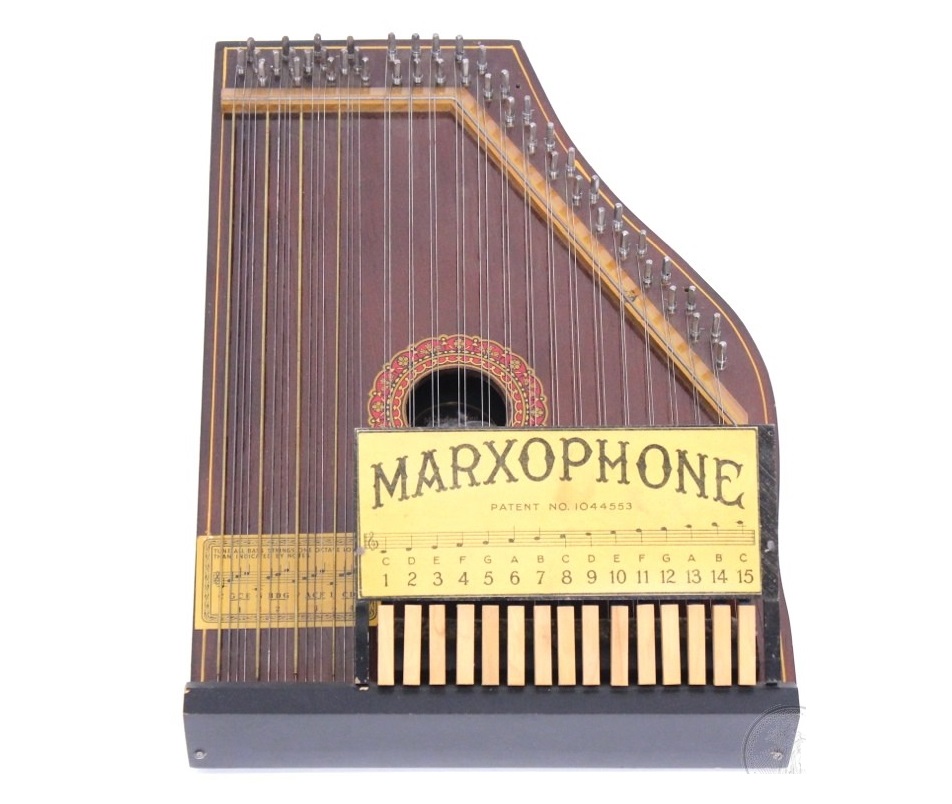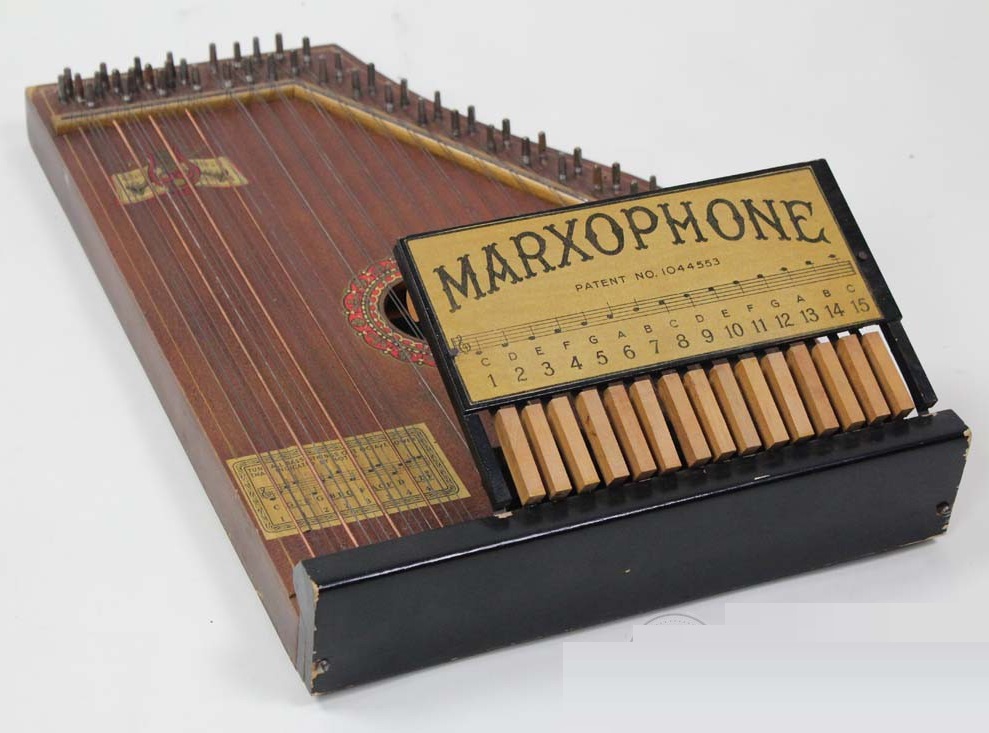Marxophone
Plucked Instruments
America
Between 1901 and present
Video
The Marxophone is a distinctive stringed musical instrument that falls under the category of fretless zithers. It features a series of metal hammers mounted on spring steel strips, allowing the player to create continuous melodies by pressing keys that trigger the hammers to strike the strings. This instrument produces a sound reminiscent of a mandolin or a hammered dulcimer, characterized by its bright, shimmering, and often tremolo-like effect.
Designed to be easily played by non-musicians, the Marxophone requires no formal training, making it an accessible and user-friendly instrument. It typically consists of a wooden resonator box with strings stretched over a bridge, and a keyboard mechanism that controls the hammers. The instrument is played by pressing the keys, which causes the hammers to bounce repeatedly on the strings, producing a rapid, oscillating sound. The Marxophone belongs to the category of chordophones, a class of musical instruments that produce sound through the vibration of strings. More specifically, it is a type of fretless zither with mechanical elements that allow for automatic striking of the strings. Unlike traditional zithers or autoharps, which require fingerpicking or strumming, the Marxophone’s unique hammer mechanism provides a continuous and rhythmic playing style that sets it apart from other stringed instruments. It is often compared to other zithers like the Celestaphone and the Dulcitone, but its defining feature is its hammer-action keys, which enable a tremolo effect with minimal effort.
History of the Marxophone
The Marxophone has its origins in the United States and was introduced in the early 20th century. It was patented in 1912 by Henry Charles Marx, an inventor based in New Jersey. The instrument was mass-produced by the Marxochime Colony, a company that specialized in novelty instruments designed for easy playability.
Although the Marxophone was primarily marketed in the United States, its design and playing technique were influenced by European zithers and hammered dulcimers, which have a much older history dating back to the Middle Ages. The Marxophone gained popularity during the early 1900s, particularly among amateur musicians, as it was promoted as an easy-to-play instrument that did not require extensive musical knowledge. While its peak popularity was short-lived, the Marxophone has remained an intriguing and nostalgic instrument. It is occasionally used in folk, experimental, and contemporary music, adding a distinctive, ethereal quality to compositions. Although production of the instrument ceased decades ago, vintage models continue to be collected and played by musicians and enthusiasts today.
Construction and Design
The Marxophone consists of a rectangular wooden soundboard, typically made of spruce or other resonant woods, with metal strings stretched across the surface. The instrument’s main design elements include:
Strings: The strings are arranged in groups, tuned to different notes, and are struck by the metal hammers when the keys are pressed.
Bridge and Resonator: The bridge supports the strings and transmits vibrations to the soundboard, enhancing resonance and projection.
Hammer Mechanism: A series of spring-mounted metal hammers rest above the strings. When a key is pressed, the corresponding hammer bounces repeatedly on the string, producing a tremolo effect.
Keyboard: The Marxophone has a small keyboard with metal levers that activate the hammer mechanism. This allows for easy and rapid playability.
The instrument is relatively small and portable, typically measuring around 20 to 25 inches in length and designed to rest on a flat surface, such as a table or lap. Its simple yet effective mechanical structure makes it easy to play without requiring complex finger movements or strumming techniques.
Types of Marxophones
While the classic Marxophone design remained largely unchanged over the years, there were minor variations in different models. These variations were primarily in string configurations, materials, and tuning systems. Some Marxophones had extended note ranges or variations in the number of strings per note, but the fundamental playing mechanism and sound remained consistent.
Characteristics of the Marxophone
The Marxophone has several defining characteristics that contribute to its unique sound and appeal:
Tremolo Effect: The bouncing hammer action produces a rapid, repeating sound that resembles a mandolin tremolo or a hammered dulcimer.
Bright and Metallic Tone: Due to the metal strings and hammer-striking mechanism, the sound is sharp, clear, and ringing.
Fixed Tuning: Unlike fretted instruments, the Marxophone has a predetermined tuning system, limiting its melodic range but ensuring easy playability.
Ease of Play: Since pressing a key activates the hammer mechanism, even beginners can produce melodies with little effort.
Playing Techniques and Sound Modifications
The Marxophone is played using a unique technique where the player depresses spring-loaded metal hammers onto the strings, creating a continuous, tremolo-like sound. This action allows for rapid reiterations of notes, giving the instrument a distinct shimmering and bell-like quality. Since it is diatonically tuned, melodies are played by striking the appropriate keys while the left hand may strum or pluck the accompanying chords on the zither-like body. Players can modify the sound by varying the force and speed of the hammering motion, adjusting the sustain and resonance. Additionally, damping certain strings with fingers or external materials can alter the tone, producing a more muted effect. Some musicians experiment with alternative tunings, electronic amplification, or effects pedals to expand the sonic possibilities, making the Marxophone adaptable to various musical styles beyond its traditional folk and parlor music roots.
Applications in Music
The Marxophone has been used in various musical genres, including:
Folk and Traditional Music: Its bright tone complements folk melodies and traditional compositions.
Experimental and Avant-Garde Music: Due to its unusual sound, it has been featured in experimental and cinematic music.
Contemporary and Indie Music: Some modern artists incorporate the Marxophone for its vintage and otherworldly quality.
Cultural Significance
The Marxophone represents an era when novelty instruments were widely marketed for home entertainment. It serves as a historical artifact of early 20th-century musical innovation, showcasing the ingenuity behind accessible and self-playing instruments. Though no longer in mainstream use, it holds nostalgic and collector’s value, appearing in recordings and performances seeking a unique timbre.
Maintenance and Care
To keep a Marxophone in good condition, players should:
Regularly tune the strings to maintain pitch accuracy. Store in a dry environment to prevent wood warping and metal corrosion. Clean the strings and hammers to prevent dust buildup affecting sound quality. Check the hammer mechanisms for any looseness or wear that may affect playability.
The Marxophone in Popular Music
Though never a mainstream instrument, the Marxophone has been used in various musical genres, particularly in folk and experimental music. Its shimmering, tremolo-laden sound adds a unique texture that cannot be easily replicated by other instruments. The Marxophone was occasionally used in early American folk recordings, adding a bright, rhythmic texture to traditional songs. The instrument found its way into recordings by artists such as The Beatles, who reportedly used it in studio sessions. Contemporary artists have rediscovered the Marxophone for its unusual sound, using it in experimental and electronic compositions.
Influence and Legacy
Despite its initial status as a novelty instrument, the Marxophone has left a lasting impression on musicians who seek distinctive tonal colors. The instrument’s unique sound continues to inspire musicians interested in vintage or alternative instrumentation.
Modern Builders: Some contemporary luthiers and instrument makers have started producing replicas and modified versions of the Marxophone.
Digital Emulation: The tremolo effect of the Marxophone has been emulated in digital instruments and synthesizers.
It is a fascinating instrument with a unique history, playing technique, and sound. Though not commonly found in contemporary music, it remains a beloved piece of musical heritage, cherished by collectors and musicians alike.
FAQ
How is the Marxophone constructed?
The Marxophone features a zither-like wooden body with metal strings. It has a series of metal hammers mounted on a spring mechanism. When a key is pressed, a hammer strikes the corresponding string, producing a repeated note due to the spring action.
What materials are used in a Marxophone?
The Marxophone is primarily made of wood for its body, metal for the strings and hammers, and felt padding to control vibrations. The keys are often made of wood or plastic, providing a smooth playing experience.
How is the Marxophone played?
It is played by pressing keys that activate metal hammers, which strike the strings and create a continuous tremolo effect. The musician can also strum or pluck the strings to add harmonic depth.
 Links
Links
References
- Marxophone | Library for Kontakt | Wavesfactory
- Marxophone - Wikipedia
- Mandolin Guitarophone (Marxophone) - Pianobook
- Zither: 'Marxophone' - Hartenberger World Music Collection
- Marxophone & Celestaphone instruments! #marxophone #piano
- The Marxophone! Possibly the finest musical instrument ever made ...
Other Instrument
Categories



















